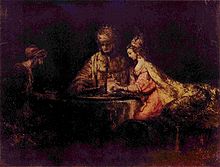- Rumyantsev Museum
-
 The Pashkov House is perched on a hill opposite the Moscow Kremlin
The Pashkov House is perched on a hill opposite the Moscow Kremlin
The Rumyantsev Museum (Румянцевский музей) was Moscow's first public museum.[1] It evolved from the personal art collection and library of Count Nikolay Rumyantsev (1754-1826), the last of his family.
Contents
History
The Rumyantsev collection was opened to the general public in 1831. It occupied the Rumyantsev House on English Quay in St. Petersburg. The museum's library was its most valuable part, since 1845 affiliated with the Imperial Public Library. It was coveted by the city of Moscow which had no public library of its own. It was Prince Vladimir Odoevsky who suggested to transfer the library to Moscow.[2] His suggestion was approved by the Council of Ministers in 1861.
The Pashkov House opposite the Moscow Kremlin was acquired to house the Rumyantsev Museum. St. Petersburgers did not welcome the relocation but were powerless to prevent it. Alexander II of Russia donated the enormous painting The Appearance of Christ before the People (Alexander Ivanov's magnum opus) for the opening of the museum. Once relocated to Moscow, the Rumyantsev collection was further augmented by valuable bequests.
The Rumyantsev Museum was split into the departments of painting, engraving, numismatics, and archaeology.[3] Another department, known as the Dashkov Museum, was established after the All-Russian Ethnographic Exhibition of 1867. It was an important centre of ethnography displaying items collected by Yuri Lisyansky, Ivan Krusenstern, and other Russian travellers.
Dissolution
The Soviets decided to shut down the museum in 1924. Despite some voices of dissent, the decision was implemented in 1927:
- the museum's collection of manuscripts and incunabula (including the Archangel Gospel) was reorganized as the Lenin Library;
- its holdings of Russian art went to the Tretyakov Gallery;
- the collection of old masters formed the nucleus of the Pushkin Museum of Fine Arts;
- the Dashkov Museum was incorporated into the Museum of the Peoples of the USSR.[4]
References
External links
- (Russian) The History of Rumyantsev Museum
Categories:- Museums in Moscow
- Museums established in 1831
- 1927 disestablishments
- 1831 establishments in Russia
Wikimedia Foundation. 2010.


